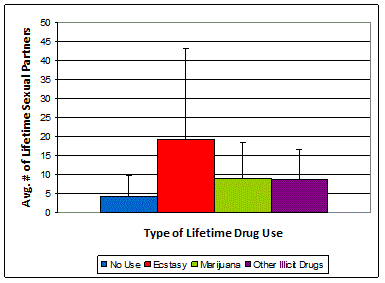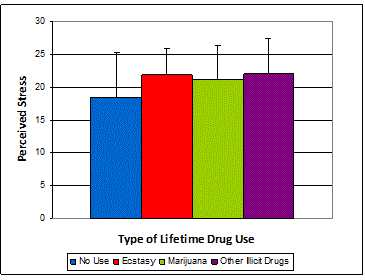Ecstasy use and misuse among young adults is an important public health concern. A recent report from the Substance Abuse and Mental Health Services Administration’s (SAMHSA) National Survey on Drug Use and Health (NSDUH, 2009) found an increase in both the incidence rate of new ecstasy users (i.e., 1.1 million new users during 2009 compared to 0.6 million during 2004, a recent low year) and the number of ecstasy-related emergency department visits (i.e., 22,816 visits, nearly double those recorded just two years earlier) (DAWN, 2007-2009), and it predicts a resurgence in ecstasy use for the years to come (CESAR FAX, 2011). However alarming, these data do not reveal the underlying reasons for ecstasy use. To develop effective interventions, researchers need to understand what factors influence young adults to use and misuse ecstasy. Recently, Wu and colleagues (2011) explored the hypothesis that ecstasy use among young, low-income women is associated with both increased stress levels and with increased risky sexual behaviors as compared to other types of illicit drug use or no drug use. This week’s STASH reviews their findings.
Method
- Participants were 407 low-income women (M age = 24.6 years; SD = 3.6; 30 % Black, 34 % White, and 36 % Hispanic) who had made a gynecological appointment at a community-based family-planning clinic in Galveston, Texas. Women were eligible if they were between 18 and 31 years old and not currently pregnant or post-partum. Of the 443 women who agreed to participate, 46 were excluded because they did not respond to survey questions.
- Participants completed an in-person survey on the day of their clinic appointment, which included the following measures:
- Self-reported substance use: Participants reported their lifetime use of the following three categories of substances: (1) club drugs (e.g., ecstasy, PMA); (2) other illicit drugs (e.g., marijuana, cocaine); and (3) licit substances (e.g., tobacco and alcohol).
- Self-perceived stress: Participants completed Cohen’s 10-Item Perceived Stress Scale (PSS-10) (Cohen, Mermelstein, Kamarck, & Hoberman, 1985). Researchers calculated a summary score ranging from 0 (low stress) to 40 (high stress).
- Risky sexual behaviors: Participants indicated their number of sexual partners, number of sexually transmitted infections (i.e., STI), consistency of contraceptive use, and engagement in other risky sexual behaviors (e.g., having sex with a stranger).
- The researchers formed three user groups based on participants’ lifetime drug use: (1) ecstasy and other illicit drug-users (including marijuana); (2) exclusive marijuana users; and (3) other illicit drug users excluding ecstasy.
Results
- As Figure 1 illustrates, women in all three drug user groups reported having significantly more stress than non-users (all t’s > 3.02, all p’s < .003).1 However, there were no significant stress differences among the drug user groups (all t’s < .87, all p’s > .38).
- Similarly, as Figure 2 illustrates, all drug user groups reported having significantly more lifetime sexual partners than non-users (all t’s > 4.32, all p’s < .001.). However, ecstasy users also had a significantly higher number of sexual partners than either marijuana users (t (142) = 3.57, p < .001) or other illicit drug users (t (88) = 2.49, p < .01).
- Additionally, compared to non-users, ecstasy users were more likely to have (1) contracted a lifetime STI (χ2 (1) = 17.0, p < .001), (2) used contraceptives inconsistently (χ2 (1) = 4.80, p < .03), and (3) experienced another risky sexual behavior (χ2 (1) = 3.35, p < .067). Users of other illicit drugs also surpassed non-users on each of these measures (all χ2 (1) > 6.11, all p’s < .014), but marijuana users only surpassed non-users on the STI contraction measure (X2 (1) = 10.86, p < .001; for the other two measures, all χ2 (1) < 1.13, all p’s > .29).

Figure. Average Perceived Stress Score and Variance (+ 1 Standard Deviation) by Drug User Group. Click image to enlarge.

Figure. Average Lifetime Sexual Partners and Variance (+ 1 Standard Deviation) by Drug User Group. Click image to enlarge.
Limitations
- This study’s cross-sectional design limits our understanding of causality among the relationships between ecstasy use, stress, and risky sexual activity. Additionally, the authors do not report correlational and mediational analyses, which would indicate the strength and direction of potential relationships among these variables.
- Because this study’s sample consisted entirely of young, low-income females, the findings might not generalize to other populations such as males and higher income groups.
- Absent physiological stress measures as a more objective alternative to self-reports, we cannot be certain about the nature of the self-reported stress.
Discussion
Women who had used ecstasy during their lifetime reported higher levels of life stress, more lifetime sexual partners, and more risky sexual practices than non-users. Increased self-reported stress was not unique to ecstasy users; indeed, the initiation of substance use in general has been linked to self-medication following stressful or potentially traumatic life events (e.g., Najavits, Weiss, & Shaw, 1997). However, ecstasy users reported having more lifetime sexual partners than women who reported using other drugs. The researchers suggest that the tactile sensitivity and altered emotions (e.g., heightened interpersonal sense of closeness) associated with ecstasy use contributes to promiscuity. Future research, informed by these findings, would appear to have potential for developing effective, targeted interventions.
-Brittany Bannon
What do you think? Please use the comment link below to provide feedback on this article.
References
CESAR FAX. (April 4, 2011). Resurgence in Ecstasy Use on the Horizon? A
Weekly FAX from the Center for Substance Abuse Research (CESAR), 20 (12). <www.cesar.umd.edu>.
Cohen, S., Mermelstein, R., Kamarck, T., & Hoberman, H. M. (1985). Measuring the
functional components of social support. In I. G. Sarason & B. R. Sarason (Eds.), Social Support: Theory, research and applications (pp. 73-94). The Hague, The Netherlands: Martines Nijhoff.
Najavits, L. M., Weiss, R. D., & Shaw, S. R. (1997). The link between substance abuse and
posttraumatic stress disorder in women. A research review. The American Journal on Addictions, 6, 273-283.
U.S. Department of Health and Human Services Office of Applied Studies. (2009).
2009 SAMHSA National Survey on Drug Use and Health: Detailed Tables. Retrieved 20 April, 2011, from http://oas.samhsa.gov/WebOnly.htm#NSDUHtabs
U.S. Department of Health and Human Services Office of Applied Studies. (2009). Drug
Abuse Warning Network (DAWN) Detailed Tables: National Estimates, Drug-Related Emergency Department Visits for 2004-2009. Retrieved 20 April, 2011, from https://dawninfo.samhsa.gov/data/
Wu, Z. H., Grady, J. J., Rosales, S., & Berenson, A. B. (2011). Ecstasy Use and Its
Correlates Among Young, Low-Income Women. Substance Use and Misuse, 46, 404-410.
________________
[1] The researchers do not present these t-test results. We have used raw data provided in the report to generate these straightforward comparisons. For additional analyses and findings, please refer to Wu, Grady, Rosales, and Berenson (2011).





Sue Guod April 20, 2011
I thought this report by Brittany Bannon was a quality piece of work. She took the time to compute some statistical tests not included in the original report. Now if she had only put the two figures parallel to each other it would have been perfect.
Best, Sue